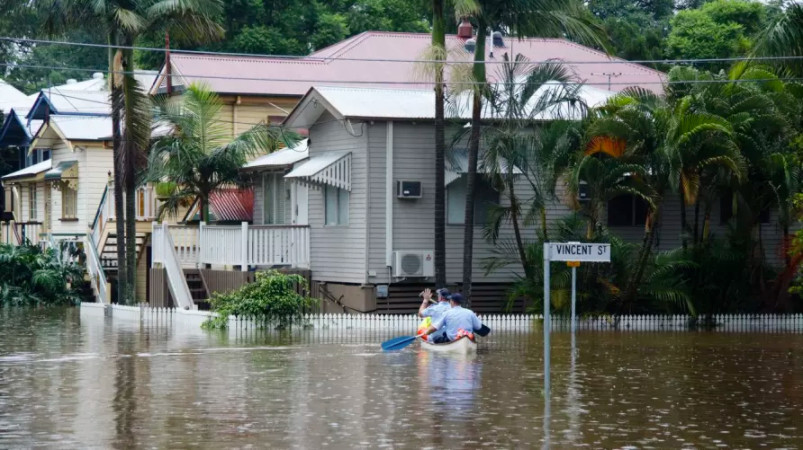
Sciences & Technology
Explaining Melbourne’s crazy but predictable weather

From 15 years of radar data, researchers show Melbourne’s rain often appears in ‘squall lines’ across the city, and they make a substantial contribution to total rainfall because of their size and motion
Published 3 September 2021
#MelbourneWeather is the butt of many jokes about gloomy winter days or four seasons in one day, and has become a typical conversation starter with your local barista or an awkward first date.
And while it’s true that Melbourne weather is variable, as Dr Linden Ashcroft and Professor Ian Simmonds point out, variable doesn’t mean unpredictable.

You’ve surely noticed the rapid temperature drop when a cold front comes through, or the sudden onset of heavy rain that often accompanies it.
But have you noticed that sometimes the clouds and rainfall appear in nice straight lines across the sky? Do you ever check out the Bureau of Meteorology’s weather radar and spot the same?

Sciences & Technology
Explaining Melbourne’s crazy but predictable weather
Well, you aren’t alone. It has long been suggested in the literature, and discussed casually by meteorologists, that rainfall in Melbourne often occurs in lines. This had yet to be quantified, though.
In research published by the American Meteorological Society in the journal Monthly Weather Review, we explored the occurrence of lines of storms in the Melbourne region, the contribution of these lines to heavy and extreme rainfall, and the different characteristics of those lines on extreme rainfall days.
To explore this ‘line’ phenomenon, we analysed 15 years of radar data from the Australian Radar Archive, using a method to identify raining systems that occur in lines.
The linear systems we looked for were large, being at least 100 km long and with rainfall of more than 2.5 mm per hr. Many of these systems would be called ‘squall lines’ - a type of organised thunderstorm.

Linear systems, and other types of thunderstorm structures, are driven by both the characteristics of the larger environment that encourage storm formation (fronts and cyclones, or the presence of coastlines and terrain), and the interaction of the thunderstorm(s) with the environmental wind (and not just at the surface).
We found that a linear system occurs somewhere near Melbourne once every six to seven days on average.

Sciences & Technology
Why more clouds can mean less rain in Australia
A typical linear system near Melbourne is oriented north-northwest to south-southeast and moves towards the east at speeds between 35 and 70 km per hour. They don’t necessarily occur in the same place each time and are more common to the east of the city than to the west, which is similar to the pattern of overall rainfall for this area.
We also found that over half of the total rainfall occurs on days that have at least one of these linear systems and that they play a bigger role in places with less frequent rain.
We suspect this is because they are one of the primary storm types for rainfall in these regions, while places with more rainfall (like over the mountains) might be more likely to get storms of other types.
Linear storms can produce severe winds, hail, tornadoes, and extreme rainfall, depending on their structures. In this work, we explored just one impact – extreme rainfall. There are many ways to define extreme, but for our purposes, ‘heavy’ events are the top five per cent and ‘extreme’ events are the top one per cent of average rainfall days.

On these heavy/extreme days, those that had linear systems contributed some 70 to 85 per cent of the rainfall. Using the fundamental ingredients for heavy rainfall, we can identify the characteristics that distinguish linear systems associated with heavy/extreme rainfall from the rest.

Sciences & Technology
Big white clouds are light and fluffy right? Wrong!
The total rainfall at any location is related to how intense the storm is and how slowly it moves. We found that on days with heavy rainfall, the linear systems had more north-south orientation, and were larger, slower and longer-lived than more ordinary linear systems.
Those on extreme rainfall days were still larger, slower, and longer-lived, but also had a greater degree of southward movement and were more likely to be associated with taller (higher altitude) and more intense storms.
This study confirms that the frequently observed linear systems aren’t simply anecdotal and, more importantly, that the rainfall on days when they occur has a substantial contribution to the total and extreme rainfall in the Melbourne region due to both their size and motion.
This and future work have potentially useful implications for forecasting, especially as we become more capable of distinguishing between those systems that bring more or less rainfall.

A better understanding of how these storms work can lead to better conceptual models and representation of physical processes in the numerical models we use for forecasting.
This can help us to better predict their timing, location and strength, as well as their hazards, ultimately for the benefit of public safety, property, and the economy.

Sciences & Technology
Turbulence: Not as dangerous as you think
Finally, changes to thunderstorms represent one of the greatest areas of uncertainty in future predictions of climate change because current climate models don’t represent thunderstorms realistically.
By understanding the types of storm structures in our region and unravelling the relevant ingredients that lead to those structures, we can explore how future changes in those ingredients might impact thunderstorm-generated rainfall. This is ongoing research as part of the ARC Centre of Excellence for Climate Extremes.
So keep an eye on the sky – and maybe you’ll spot one of these staple features of our beloved #MelbourneWeather.
The research team included Robert Warren and Joshua Soderholm from the Bureau of Meteorology.
Banner: Getty Images